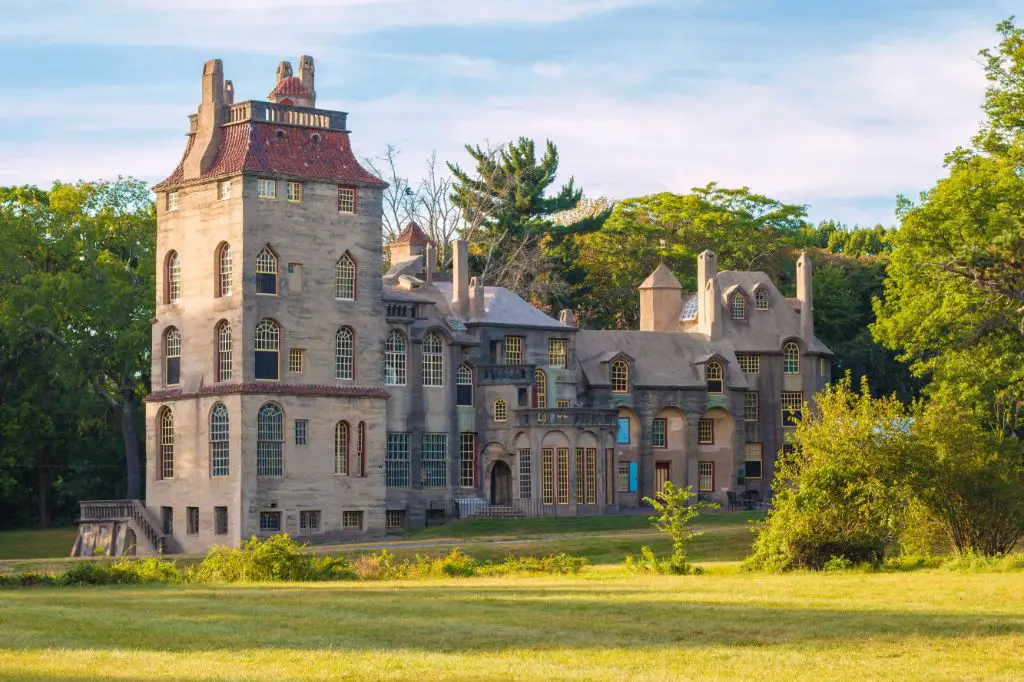Why Is Fonthill Castle Famous?
Fonthill Castle is a grand home built in the early 20th century that captured the public’s fascination but also met an untimely demise. Located in Doylestown, Pennsylvania, it was the home of Henry Chapman Mercer, an archaeologist, anthropologist, tile maker, and antiquarian. Constructed between 1908-1912 in a concrete form of Mercer’s own design, Fonthill Castle embodied Mercer’s romantic notions of medieval castles. With its eye-catching architecture featuring towers, turrets, and arched windows and doors, Fonthill Castle became famous as an architectural curiosity that attracted sightseers. However, structural issues led the castle to eventually collapse in the mid-1900s. Today, Fonthill Castle exists only in ruins, but retains its aura of mystery. Its legacy continues through Mercer’s Moravian Pottery and Tile Works and Fonthill Museum. The story of Fonthill Castle’s rise and fall reveals one man’s artistic vision and grand ambitions, as well as the fleeting nature of human creations.
William Beckford’s Grand Vision
William Beckford was an eccentric English writer, art collector and politician who amassed great wealth through inheritance and overseas plantations. He envisioned building a grand Gothic abbey and estate that would showcase his wealth and passions for art and architecture. Fonthill Abbey —also known as Beckford’s Folly—was this vision brought to life through immense expenditure and ambition.
Born in 1760 to a wealthy family, Beckford inherited a vast fortune including sugar plantations in Jamaica. This income, along with his passion for art collecting, enabled him to embark on building Fonthill Abbey in 1796. Beckford spent lavishly to construct his Abbey in the Gothic Revival style, sparing no expense on ornate detailing and rich interiors.
Beckford was known for his eccentricities and extravagant tastes. At Fonthill, he filled the house with his expanding art collection and built a 280-foot tower purely for viewing the countryside. The Abbey became an embodiment of Beckford’s wealth and imagination. Through Fonthill, he sought to create an artistic paradise that demonstrated his status and aesthetics.
The Rise of Fonthill Splendor
In the early 20th century, author and antiquarian William Beckford embarked on building Fonthill Castle, which would become his magnum opus. Located in Wiltshire, England, Fonthill Castle was Beckford’s vision of a grand Gothic Revival palace, drawing inspirations from literature and medieval architecture.

Construction on Fonthill Castle began in 1796 under the direction of architect James Wyatt. Beckford spared no expense, using the finest materials and craftsmen to realize his ambitions. The main tower soared to over 270 feet, making Fonthill the tallest non-reinforced concrete structure in Europe at the time https://www.mercermuseum.org/about/fonthill-castle/.
The castle featured elaborate decorative elements inside and out. The exterior façade boasted intricate stonework and huge arched windows in the Gothic style. Inside, no surface was left unadorned with lavish woodwork, stained glass, furniture, paintings and more in a dizzying array of patterns and textures https://www.phillyburbs.com/story/lifestyle/2023/02/12/fonthill-castle-in-doylestown-grounds-to-be-improved-bucks-county/69889461007/. Beckford’s vision was to create an imaginative Gothic world that blurred the lines between fantasy and reality.
The Fall of the Castle
The original Fonthill Abbey, constructed in the late 18th century, was an ambitious structure with a 288-foot tower designed by James Wyatt. However, the tower was structurally unsound and collapsed several times over the years.
In 1825, the Great Tower at Fonthill Abbey collapsed for the final time, severely damaging the western wing of the abbey (https://en.wikipedia.org/wiki/Fonthill_Abbey). This event marked the beginning of the end for the original Fonthill Abbey structure. Much of the abbey was subsequently demolished and scavenged for building materials.
Additional demolitions continued in the coming decades. By 1845, most of the main abbey building had been dismantled or destroyed. The gothic west entrance and some outer walls were all that remained of William Beckford’s grand vision.
Artistic Significance
Fonthill Castle played an important role in the history of arts and patronage in England during the late 18th and early 19th centuries. The eccentric William Beckford poured his vast inherited wealth into building the castle, filling it with artworks, and hosting literary figures there. Beckford designed Fonthill to showcase his grand art collection, which included over 400 paintings and thousands of books and prints.
Fonthill served as a retreat for writers and artists under Beckford’s patronage. During the castle’s heyday, he frequently hosted gatherings of prominent cultural figures such as novelist Horace Walpole, landscape designer William Chambers, and artist J.M.W. Turner. Beckford’s lavish hospitality and lively conversation deeply influenced them and others. Fonthill thus functioned as a nexus of arts, ideas, and inspiration in British society at the time.
While only in residence at Fonthill for around 20 years, Beckford poured immense resources into the castle as a monument to his aesthetic vision. The building itself, with its exotic architecture and soaring Gothic tower, was intended as a grand artistic statement. Although Fonthill fell into ruin after Beckford’s departure in 1822, its legacy as an important center of arts patronage endures.
Ruins and Relics
After Fonthill Castle collapsed in 1910, only fragments of the eccentric structure remained. The ruins became an archaeological site, offering glimpses into Henry Chapman Mercer’s unique vision. Archaeologists carefully documented and studied the remnants, which included pieces of Mercer’s prized Moravian-style tiles, decorative elements, and structural concrete.
Though much of Fonthill was lost, archaeological excavations in the 1960s and 1970s uncovered parts of the foundation and lower levels. These ruins provided valuable insights into Mercer’s pioneering use of reinforced concrete. Mercer was one of the first to employ concrete in this ambitious manner for domestic architecture. The durability of his concrete tiles also became evident, as many survived the castle’s dramatic demise.
Today, the Fonthill ruins remain open to visitors. The archaeological fragments showcase Mercer’s forward-looking construction techniques, creativity, and persistent pursuit of his idealized medieval castle. Though Fonthill only stood for a few years, its relics continue to intrigue architects, artists, historians, and tourists.
Influences on Culture
Fonthill Castle has had a significant influence on culture, art, media and literature over the past century. The Castle’s unique Gothic Revival architectural style served as inspiration for various artists. For example, Andrew Wyeth, one of America’s best known realist painters, created several paintings of Fonthill including The Fenithill Weathervane in the 1960s (1). Architect Frank Furness also toured Fonthill and incorporated design elements into his iconic buildings like the Pennsylvania Academy of Fine Arts in Philadelphia.
Beyond visual art, Fonthill Castle has made appearances in popular literature as well. In E. Boyd Smith’s novel The Architecture of Country Houses, Fonthill was described as the “American castle that most closely embodied the Gothic spirit.” (1) It served as the setting for several scenes in M.M. Bakhtin’s Toward a Philosophy of the Act. More recently, parts of Fonthill were incorporated into Dianna Wynne Jones’ fantasy series Dalemark Quartet as the mansion called Kredindale.
The castle ruins have also been featured in films and television. The 1980 horror movie The Awakening used Fonthill as a filming location, as did the PBS documentary Henry Mercer: Your Obedient Servant in 1980. Most recently, an episode of Ghost Hunters investigated the property for paranormal activity in 2019.
Overall, Fonthill Castle’s dramatic architecture and ruined state have long inspired artists, authors, and filmmakers to feature it in their works across many genres. It remains an iconic example of Gothic Revival architecture with enduring influences in pop culture.
Legacy and Lore
Fonthill Castle has inspired many legends and lasting memories throughout its history. Though the castle itself no longer stands, stories of its magnificence and mystery continue to captivate the imagination.
One popular legend claims that the castle was designed with a complicated system of secret passages, hidden rooms, and concealed staircases throughout its 44 rooms and 200 windows. This mystique led to tales of treasures being hidden within the castle walls (Mercer Museum & Fonthill Castle).
The abrupt collapse of the castle’s tower in 1912 also fueled speculation. Some believed it was a bad omen, while others saw it as an allegory for the decline of Mercer’s eccentric dream. This dramatic event only added to the ruins’ aura of romance and decay in the public consciousness.
Though Fonthill Castle itself vanished, its influence persisted through literature and art. Gothic novels like Edgar Allan Poe’s The Fall of the House of Usher drew inspiration from Mercer’s crumbling vision. Fonthill’s silhouette even made an appearance in the films of surrealist Luis Buñuel.
Today, Fonthill’s remnants and reproductions scattered across museums still enchant visitors. The legacy and mystique of Mercer’s ambitious architectural feat remains alive through story and imagination.
Tourist Attraction
In modern times, the ruins of Fonthill Castle have become a popular tourist attraction. The site is managed by the Mercer Museum and is open for public tours from Tuesday through Sunday [1]. Visitors can explore the ruins and learn about the history of the castle through interpretive displays and audio tours.
Fonthill Castle provides a unique opportunity to step back in time and imagine what the grand estate looked like in its heyday. According to the museum’s website, tour tickets start at $18 for adults, $16 for seniors, and $13 for youth [2]. Special events and programs are also held periodically at the castle.
The museum offers directions and parking information to make it accessible for tourists. With its awe-inspiring ruins and fascinating history, Fonthill Castle remains a captivating place to visit for curious travelers today.
Conclusion
Fonthill Castle stands as a unique and extraordinary testament to the vision and passion of Henry Chapman Mercer. Though only a ruin today, its fame stems from its origins as Mercer’s hand-crafted architectural wonder, reflecting his unconventional spirit and antiquarian obsessions. The castle encapsulated Mercer’s dedication to handmade design and the Arts and Crafts movement through its hand-mixed concrete construction and vast collections of tiles, ceramics, books, and artifacts. A highly personal endeavor, Fonthill Castle expressed Mercer’s eclectic tastes and conveyed his romantic ideals of the past. While never completed and prone to structural issues, the castle’s ambitious scale and imaginative style left an indelible mark. Even in ruin, Fonthill Castle continues to inspire fascination as an idiosyncratic work of art and an enduring legacy of Mercer’s creative vision.





